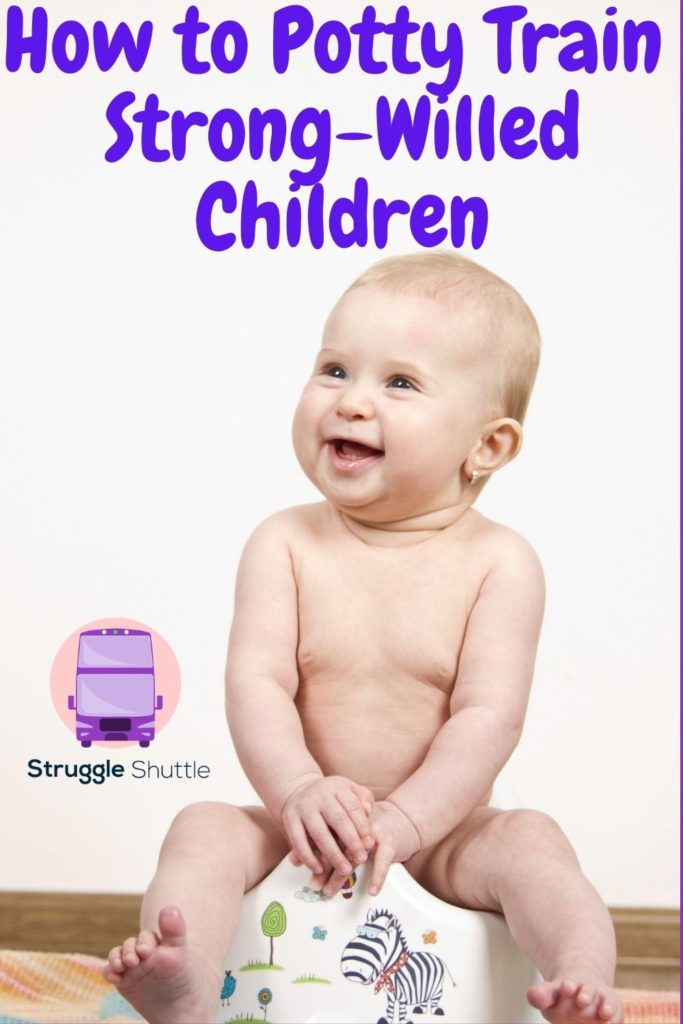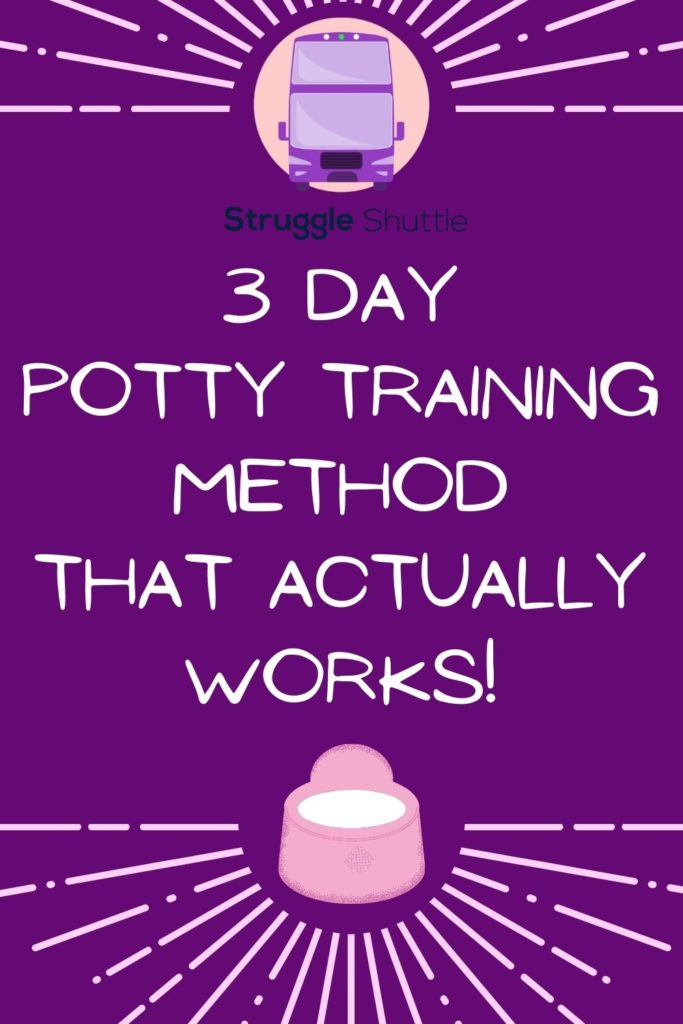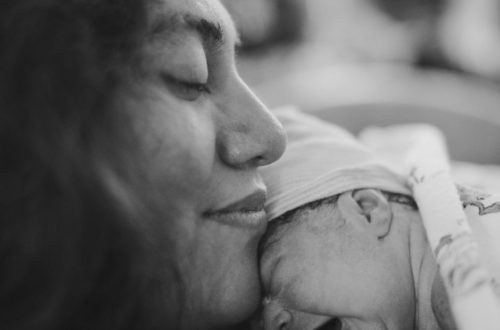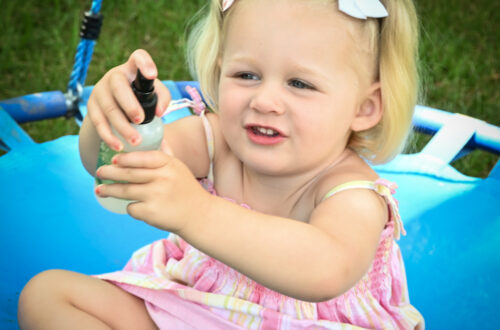
Toddler Refuses to Sit on Potty | When to Start Potty Training
Ready to start potty training but your toddler refuses to sit on potty? Maybe your child is showing all the “signs” that the potty training books you’ve read say to look for but you are still experiencing potty training refusal?
I’ve been there, too. It can be so frustrating! However, these are simply signs of a strong-willed child. They just don’t want to do anything that isn’t “their idea”. They need to feel like they have control. So when potty training day comes, for kids like this, your potty training method is extremely important.
How do you know that when your toddler refuses to sit on potty it’s because they are strong-willed?
Do you hear, “I do myself!”, all day long? Does your child get visibly upset if they can’t do something or you do something that they wanted to do? Does your child avoid/refuse to do things that they have not yet mastered/say that they “cannot” do? If so, then you have a strong-willed child! And your strong-willed child hasn’t yet mastered toilet training so they are refusing to do it!
So, if your strong-willed toddler refuses to sit on potty, when do you start potty training??
When to start potty training your strong-willed child is just as important as what method you use during the training process. All of the potty training books that I have read say to start potty training, “when your child shows interest in the potty”. This, however, was not the case for me…My toddler first showed interest in the potty around 13/14 months old. The first time that she peed on the potty she was 15 months. I was convinced that I would have her potty trained in no time! However, my daughter wasn’t potty trained until over a year later! Here’s why:
Strong-willed children need to feel like they are in control. For toilet training, that means bladder control!
Waiting for your toddler to show signs of bladder control before starting potty training will not only increase your chances for potty training success but also reduce the messes you will have to clean up!
Statistically speaking, 66% of children under 3 years old can hold their bladder for 10-12 hours. You will first see this control at nighttime. This is especially true when you have a strong-willed child. More than likely, your toddler refuses to sit on potty during the daytime because it means that they are “missing out on what THEY want to do” (i.e.play). However, they still do not like the “feeling” of a dirty diaper. During the daytime they will more than likely start:
1. Hiding before using their diaper.
2. Taking their diaper off after they use it.
3. Grabbing a diaper for you/ telling you that they need changed.
When your toddler starts showing these signs. they are also more than likely waking up with a dry diaper even after 12+ hours of sleep! That is because they don’t like the feeling of sitting in a dirty diaper and they CAN control their bladder. Your strong-willed child is ready to be potty trained!
Waking up with a dry diaper is the most effective time to start potty training!
When potty training a strong-willed child it is important to do daytime and nighttime potty training together. These are “all-or-nothing” kids. The reason you toddler refuses to sit on potty includes fear of failure. Attempting to potty train children like this too early can lead to regression due to feelings of disappointing you and themselves by having potty training accidents. Waiting until they display nighttime bladder control before toilet training is the best way to prevent accidents and instill confidence in themselves.
**Waiting until my daughter was consistently dry each morning before starting potty training resulted in ZERO NIGHTTIME ACCIDENTS!!

Once you know your strong-willed child is ready to start the training process, what potty training method should you use?
My mother-in-law has been doing child care for 40+ years and has successfully potty trained countless numbers of children. Her “fail proof” method includes putting underwear on before the diaper/pull up. This method for toilet training has worked for numerous children that also hate the feeling of being wet because the underwear prevent the diaper from absorbing all of the wetness. This causes the child to have to fully experience the feeling of wetting themselves without making a mess on the floor or other clothing.
This sounded like the perfect potty training method for my daughter! Spoiler alert, it didn’t work. If your child is as strong-willed as mine then they will simply continue to use their diaper and show ZERO aversion for the wet underwear.
**PRO TIP: Once your toddler is potty trained, then let them pick out their own “big girl/boy” underwear!
Another method that didn’t work for me was potty training rewards. I have seen so many moms with charts in their bathrooms to put stickers on for successful attempts. I have read several books and potty training tips that include rewards such as food, toys, playdates, etc… If that works for you, great! But if you’re kid is like mine, they will only go sit on the potty because they want candy. The only concept that they are understanding is that they can control their candy consumption.
Related Post: 20 Gifts for Toddlers Under $20
Developing potty training progress with a strong-willed toddler means letting them be in the drivers seat. You can do this by allowing them to have “control” of everything.
Make potty training easier for them by making sure that they can do/”control” every aspect of the potty training process.
1. Set aside 2-3 days to stay at/around your home to complete potty training. It’s more effective for children to be in familiar places when they are learning new skills. Reducing the number of new elements in their world allows them to concentrate on the one new thing that they are trying to learn. Picking a primary bathroom and toilet also help to increase their comfort level and reduce their anxieties.
**Do NOT put toilet in a room that is not the bathroom! A lot of potty training tips that I have read in the past say to put the toilet in their play area or in front of the TV so that the child doesn’t “miss out” on playtime. However, if you want your child to take potty training seriously then it needs to be done appropriately (meaning in the appropriate room). In my experience, putting the special potty seat in a playroom instantly turns it into a toy that dolls/stuffed animals use to potty but not your child!
2. When picking a toilet or toilet seat cover for your child to use LET THEM PICK IT OUT! Allowing them to form an attachment to the training toilet/cover increases their desire to actually USE it! However, I’m not saying that you have to take them to the store just to have them end up picking the Cadillac of toddler toilets that you can’t afford. Simply give them a few options (I did this buy showing her some on my phone) that are within your price range and let them pick! You can even find barely used seats on Facebook marketplace if you’re looking for a more affordable option.
Related Posts: Be Boujie on a Budget & FREE Programs that Give You FREE Cool Stuff
3. Get a stool/ladder! If your toddler refuses to sit on potty it’s because strong-willed children must do everything themselves! If they cannot reach the toilet (if using a special potty training seat) or the sink to wash their hands then they will not want to do it. Any ways that you can make it so that they can complete a potty session without your assistance the better! Here are a few of our favorite stools/step ladders:
**PRO TIP: You may need to get multiple step ladders or stools for different bathrooms or even the kitchen if your toddler like to cook with you like mine!
4. Set a timer for when they need to use the restroom. Depending on how long your child typically goes between diaper changes, choose a starting length of time about half that time. We started with every 45 minutes. As your child starts to understand the potty training adventure you can increase the time between potty sessions.
You can set this timer multiple ways. The easiest options (because you likely already own them) would be to set the timer on your oven or phone. The problem with these is that you have to remember to reset them each time. Also, if using your phone, you must make sure it stays near your child so that they hear it. The BEST option for setting a timer that I have found is to buy a potty training watch. This gives your toddler even more control as they will be wearing it. All you have to do is set the time interval on the watch and then it will automatically go off after each allotted time period.
**The most important aspect to choosing a timer method for potty training is that is consistent! Do not change the source of the alarm (i.e. your phone vs your spouses) or the sound of it. Your child will quickly start registering this particular sound as meaning time to use the restroom.
5. Choosing the ultimate potty training outfit! A lot of potty training books say to let your child pick out their own underwear for potty training. The belief behind this is that they usually pick underwear with their favorite characters on them. When they choose these underwear you can tell them not to get <insert favorite character here> wet and that will/should deter them from peeing in them. Great concept, but it didn’t work for me. Baby Shark was “swimming” all the time. As it turns out, kids that can feel anything on their diaper area assume it is a diaper.
The best method is commando potty training.
Eliminate underwear/diapers completely for these 2-3 days. This also gives your child more confidence as most 2 year olds have not yet mastered pulling up AND down their pants yet. Because our house has a lot of floor to ceiling windows for neighbors to see in we kept out daughter in a nightgown/large shirt for these 2-3 days. If your house is private enough then naked potty training is also an option.
Before starting your potty training adventure with these potty training tips, please note that:
1. There will be accidents. When naked potty training make sure to choose an area of the home with the least amount of carpet or put something down to protect your floors if necessary.
2. Try not to get frustrated. Your child will have accidents and they will also not always produce during “potty time”. That is okay! Simply tell them that accidents happen and they can try again next time. Children are more responsive to positive feedback and encouragement rather than shame or punishment.
**You may want to adjust the alarm to off again in half the original time if the didn’t produce. Continue to cut the time in half until they use the potty. Then continue the training process by restoring the alarm to the original time allotment.
The first potty training day will be the most difficult.
However, once your child understands the meaning behind the alarm and realizes that they can do everything themselves without “needing you” it will get easier! The second day you may still have a couple accidents but you will start to notice that your child comprehends and can identify the urge to use the restroom right before the accident occurs. The third day will be as close to a master at potty training as you could possibly ask for!

On/after day 3 of potty training you are going to want to start going out on short trips (i.e. grocery store, get gas, etc…). Potty training tips for first outtings:
1. Ask before leaving if your child has to go potty. If not, go anyways. TRY TO TRUST YOUR TODDLER.
2. Ask them while in the store and/ SHOW them the bathrooms in different places.
3. Bring a collapsible stool with you if your child MUST do it all himself.
4. Pack a change of clothes (just incase).
5. Keep a special potty training seat in your car. We have an SUV and keep this seat in the hatchback incase she has to go while on a trip. We like this seat because it has grips on the bottom that help to keep it in place rather than flying all around my car.
This potty training method was the ONLY method that worked for us and our strong-willed child! If your toddler refuses to sit on potty too it DOES NOT mean that they aren’t ready for potty training. It just means that they are strong-willed and refusing to do something they can’t control/haven’t mastered yet. I hope that with these potty training tips your strong-willed child will embrace potty training as quickly and seamlessly as my daughter and the multiple other kids that have since used this potty training method!
Best wishes on your potty training adventure!








15 Comments
Eileen M Loya
My grandson is a strong willed child and his usual responses are “Me can do that.” or “Me fix. You sit.” He wasn’t difficult to potty train though. It just came naturally and it was such a big accomplishment. I will be sharing these tips with my daughter’s best friend. She has a child that is just about the right age to be potty trained.
Gervin Khan
I am glad that I am done with this. These are great tips for all moms, most especially the new ones.
Kimmy
All great tips and exactly the signs my kiddos give me. Working on potty training my youngest
Sally
I’m thankful I’m well past this stage. My daughter loved books so I would get her to sit with a book and read to her.
Catalina
I’ve started potty training when my kid was 24 months, and it was easy. I admit that I’ve tried to do it earlier but it was to confusing for both of us, so I gave up. At 24 months things were different and definitely easier.